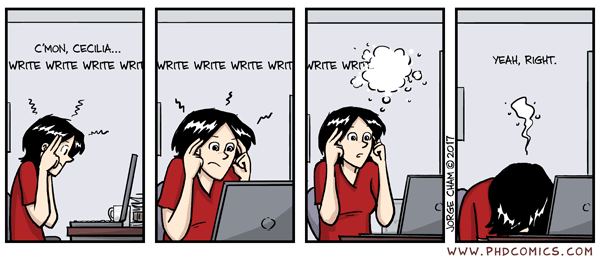In a few weeks, I’ll be heading to Arizona with my husband and our preschooler. We’ll be on vacation for 13 days, and I will not bring my laptop. That’s because I practice what I preach as a writing consultant and academic-productivity specialist: Don’t just finish your monographs and articles on time — finish them on time without compromising your quality of life.
I ask every client I work with — whether a graduate student writing a dissertation or an academic working on a book or article — to take semester breaks actually, unequivocally, 100-percent off. Decompress. Enjoy (or “enjoy”) their families. Or just spend a week or two walking around in the fresh air, lingering over a fun conversation in a cafe, or binge-watching NewsRadio reruns and eating Red Vines at 9:30 a.m. Whatever.
The secret to taking holidays off is to be all caught up on your work plan before they start. And the way to be caught up on your work plan before the holidays start is to have a work plan. You’d be amazed (or not) at the number of perpetually aggrieved academics I know who don’t. They just sort of launch themselves in the general direction of their research a few times a month, and then — you guessed it — sequester themselves miserably for a few weeks of life-ruining lockdown right before their deadline.
If you actually want to have a happy relationship with your work, you need a prescription for exactly what you want to do every day. Yes, it can feel overwhelming to executive-function intellectual labor. But I guarantee that spending a 10 minutes a day (plus about 30 minutes at the top of the week) organizing your writing projects will save incalculable time and effort down the line.
The key to a successful work plan is to start a project — an entire monograph, a chapter, an article — with a healthy work trajectory and a clear-cut blueprint. Only you know how you best impart new information into your big, smart noggin, so I won’t presume that the structure I’m about to suggest will work for everyone. I will, however, presume that it will work 100 percent better than the most popular competing “strategy”: fretting and doing nothing.
Step No. 1: Write first. Possibly the most unconventional suggestion I give clients for creating a first draft is: Write first, then read, then write again, read more, and write one last time.
That flies in the face of the general wisdom that faculty members impart to undergraduates, which is to read the material carefully before they write a word. And for them, that holds — but not for you, because you have already spent upward of two decades reading and writing smart things, and you’ve almost certainly read the primary source material of your project at least once.
Most of you don’t follow that advice when you start a project. Instead you spend an untold amount of time attempting (and failing) to read Everything — every book, article, paragraph that could ever be relevant to your topic. Then you proceed to get more than a little psyched out by the polished quality of the published work: Will I ever be as good as this? Oh, no, what if I’m not? I’m not! I’ll never be! Hey, my couch needs vacuuming.
Yeah, don’t do that. Instead, at the beginning of a project — even if you have only the vaguest idea what it should be about — I suggest you set aside a week and free-write. On each workday of that week, spend 25 minutes twice a day (two “pomodoros” a day) and write down all the things that you know, want to know, are interested in, are confused, or are excited about in your new venture. Don’t try for paragraphs or even full sentences. Revel in the mess.
At the end of that week, you may have 1,000 to 4,000 words of semi-gibberish — but it holds the key to your future brilliance.
Step No. 2: The baby bibliography. From that inspired semi-gibberish, you will then mine your first annotated bibliography. And the annotations are the most important part. You should never read anything without writing something down about it. Look up about 10 sources on your subject — the 10 best or, at any rate, the most famous, or most recent and “exciting,” or most in vogue, or most something. Just start somewhere. For approximately two weeks, spend every work session reading (or rereading) those sources carefully, creating a full bibliographic entry for each one. Annotate each entry with:
- The source’s main thesis.
- Its primary impact on the field.
- Two or three representative quotes.
- Your own opinion about the source — what you think is brilliant, what you think is flawed.
Step No. 3: A skeleton draft. Using your baby bibliography, begin to merge some of your insights with your free-writing to form a primordial outline. You know how.
- Organize under subject headings all the quotes, summaries, and opinions inspired by your free-writing.
- Copy, paste, shape, and cut stuff.
- Always, always create another document to save everything you’ve cut.
- Make note, at every turn, of unanswered questions. This is, in effect, the most important part: It’s the part you can’t write yet.
What you’ll have at the end of about two weeks — provided you work on this in two or three 25-minute sessions a day, five days a week — is essentially a skeleton. It will have the vague shape of an article or chapter but will ask a lot more questions than it answers and will have a fair share of bracketed “notes to self” (à la Find a thing that ties these two ideas together).
Step No. 4: Close reading. Your skeleton draft is also a road map. Instead of attempting to read Everything (which you will never do), you now know what sorts of sources you need to find and read in order to flesh out your arguments and fill in the gaps. To identify those new sources, look to household names in your field, to scholars you’ve met at conferences, to people with whom you already collaborate, to that one exciting new hotshot you keep hearing about. And, of course, consult the bibliographies of your first 10 sources. Get to mining!
With an expanded list of sources in hand, it’s time to read more intensely. Spend the next three to six weeks diving into those new sources and expanding your annotated bibliography. Again, do the reading two or three times a day, in 25-minute sessions, five or so days a week. Give yourself a deadline: Set a specific number of work sessions (such as 20 or 30), and when you’ve reached that number, cut yourself off. (Don’t worry, you’ll soon have time to read more.)
Step No. 5: A workable draft. At this point, you’re ready to dive into your now-massive annotated bibliography and do more surgery. All those unanswered questions you had scribbled down in your free-writing? It’s time to fill in the gaps. Extract quotes, summaries, and arguments (copy, don’t delete, them from the bibliography), and paste them into the appropriate places in your Skeleton Draft. Your writing here can still be rough — don’t trip yourself up worrying about transitions or squaring all the circles. This stage of writing is chaos. If it feels uncomfortable, you’re doing it right.
By the end of this step, you will have a slightly more fleshed-out draft. Your next task, then, is to spend another two to three weeks tinkering on the sentence level, working on those transitions and cleaning up unnecessary jargon. Follow the same basic work schedule: two to three 25-minute writing sessions a day. At the end of those weeks, you may still have more holes to fill (especially in the footnotes.) But, by and large, you will have, miracle of miracles, a real draft of a chapter or an article that’s 25 to 30 pages long.
From start to finish, the process will take 11 to 14 weeks — about the duration of a semester — of working on the project for no more than an hour or two a day. With a workable draft in hand, now is a great time to put it aside and let it breathe, as your backbrain spins its wheels while you’re on break in earnest.
I know, I know — a fat lot of good this advice is doing you now, as you’ve once again put off your research agenda until the three weeks of winter intersession that you’re already dreading. But take comfort: Spring break will be here soon — and by then, at least, you will have a plan.

